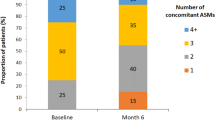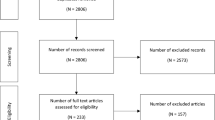Abstract
Introduction
Although ethosuximide is one of the oldest antiepileptic drugs (AEDs), little information is available about the cognitive side effects of ethosuximide.
Objective
The aim of this study was to investigate the cognitive profile of ethosuximide.
Methods
In this cross-sectional study, we used an extensive neuropsychological test battery in patients with epilepsy aged 6–16 years who were treated with monotherapy ethosuximide. We evaluated the efficacy of the drug by seizure frequency (seizure free or not).
Results
We included 61 patients with a mean age of 9.4 years [standard deviation (SD) 2.7] who used on average 686 mg/day (SD 245) ESM as monotherapy. ESM was effective in the majority of the patients (70 % were seizure free for at least 6 months at moment of inclusion). The total study population showed impairments of intelligence, visuomotor, and attentional function including activation/alertness. Comparisons between the well-controlled patients and patients who were not in remission showed significantly lower intelligence values and lower performance on the visual-perceptual and attentional tasks for the group with ongoing seizures. Our results suggested that the higher order cognitive dysfunctions (such as intelligence and visual-perceptual functions) may be regarded as seizure or aetiology effects and that the impaired fluid cognitive functions, such as activation/alertness, sustained auditory attention and attentional control or switching, were due to ESM.
Conclusion
This study suggests the attentional dysfunction resulting in psychomotor slowing and alertness deficits may be regarded as effects of ethosuximide. Although no untreated baseline assessment was available, these effects are comparable to those of other AEDs, and ethosuximide may therefore be considered an AED with only mild effects on cognition. As ethosuximide is a first-line therapy for absence seizures in childhood, and drug-induced cognitive impairment may interfere with development, learning, and academic achievement, these findings are of interest to clinicians who prescribe this drug, especially when informing parents.

Similar content being viewed by others
References
Posner EB. Absence seizures in children. BMJ Clin Evid. 2013;12:317–332.
Caraballo RH, Dalla Bernadina B. Idiopathic generalized epilepsies. In: Dulac O, Lassonde M, Sarnat HB, editors. Handbook of clinical neurology. Oxford: Elsevier Science; 2013. p. 579–89.
Glauser TA, Ben-Menachem E, Bourgeois B, et al. Updated ILAE evidence review of antiepileptic drug efficacy and effectiveness as initial monotherapy for epileptic seizures and syndromes. Epilepsia. 2013;54:551–63.
Shinnar S, Cnaan A, Hu F, et al. Long-term outcomes of generalized tonic-clonic seizures in a childhood absence epilepsy trial. Neurology. 2015;85:1108–14.
Patsalos PN. Properties of antiepileptic drugs in the treatment of idiopathic generalized epilepsies. Epilepsia. 2005;46:140–8.
Zimmerman FT, Burgemeister BB. A new drug for petit mal epilepsy. Neurology. 1958;8:769–75.
Callaghan N, Ohara J, Odriscoll D, et al. Comparative study of ethosuximide and sodium valproate in the treatment of typical absence seizures (petitmal). Dev Med Child Neurol. 1982;24:830–6.
Sato S, White BG, Penry JK, et al. Valproic acid versus ethosuximide in the treatment of absence seizures. Neurology. 1982;32:157–63.
Martinovic Z. Comparison of ethosuximide with sodium valproate. In: Parsonage M, Grant R, Craig Jr AW, editors. Advances in epileptology, XIVth epilepsy international symposium. New York: Raven Press; 1983. p. 301–5.
Glauser TA, Cnaan A, Shinnar S, et al. Ethosuximide, valproic acid, and lamotrigine in childhood absence epilepsy. N Engl J Med. 2010;362:790–9.
Glauser TA, Cnaan A, Shinnar S, et al. Ethosuximide, valproic acid, and lamotrigine in childhood absence epilepsy: initial monotherapy outcomes at 12 months. Epilepsia. 2013;54:141–55.
Masur D, Shinnar S, Cnaan A, et al. Pretreatment cognitive deficits and treatment effects on attention in childhood absence epilepsy. Neurology. 2013;81:1572–80.
Mandelbaum DE, Burack GD, Bhise VV. Impact of antiepileptic drugs on cognition, behavior, and motor skills in children with new-onset, idiopathic epilepsy. Epilepsy Behav. 2009;16:341–4.
Grevers E, Breuer LEM, IJff DM, et al. Mental slowing in relation to epilepsy and antiepileptic medication. Acta Neurol Scand. 2016;134(2):116–22. doi:10.1111/ane.12517.
IJff DM, Aldenkamp AP. Comorbidities of treatment with antiepileptic drugs. In: Duchowny M, Cross JH, Arzimanoglou A, editors. Pediatric epilepsy. New York: McGraw-Hill Professional; 2012. p. 424–36.
Wechsler D. Wechsler Intelligence Scale for Children derde editie NL, Handleiding en verantwoording. Amsterdam: Harcourt Test Publishers; 2005.
Beery KE, Beery NA. The Beery-Buktenica developmental test of visual-motor integration, administration, scoring and teaching manual. 5th ed. Minneapolis: NCS Pearson; 2006.
Kalverboer AF, Deelman BG. De 15-woorden tests A en B : (een voorlopige handleiding) (15WT/VWT). Groningen: Academisch Ziekenhuis Groningen, afd. Neuropsychologie; 1986.
Alpherts WCJ, Aldenkamp AP. FePsy: ‘The Iron Psyche’. Heemstede: Instituut voor epilepsiebestrijding; 1995.
Vos PG. Bourdon-Vos test handleiding. Swetss test services; 1988.
Manly T, Robertson I, Anderson V, et al. Test of Everyday Attention in Children. Amsterdam: Pearson; 2004.
IJff DM, Aldenkamp AP. Cognitive side-effects of antiepileptic drugs in children. In: Dulac O, Lassonde M, Sarnat HB, editors. Handbook of clinical neurology. Oxford: Elsevier Science; 2013. p. 707–18.
Donati F, Gobbi G, Campistol J, et al. Effects of oxcarbazepine on cognitive function in children and adolescents with partial seizures. Neurology. 2006;67:679–82.
Author information
Authors and Affiliations
Corresponding author
Ethics declarations
Conflict of interest
Dominique M. IJff, Tamar M. van Veenendaal, Mariette H. Debeij-van Hall, Jacobus F.A. Jansen, Anton J.A. de Louw, Marian H.J.M. Majoie, and Albert P. Aldenkamp have no conflicts of interest.
Funding
This research did not receive any specific grant from funding agencies in the public, commercial, or not-for-profit sectors.
Research involving human participants
All procedures performed in studies involving human participants were in accordance with the ethical standards of the institutional research committee and with the 1964 Helsinki declaration and its later amendments or comparable ethical standards. Formal consent is not required for this type of study (retrospective).
Informed consent
Every patient referred to our tertiary referral center is asked to give permission for their data to be used for research. Informed consent was obtained from all individual participants included in the study.
Rights and permissions
About this article
Cite this article
IJff, D.M., van Veenendaal, T.M., Debeij-van Hall, M.H. et al. The Cognitive Profile of Ethosuximide in Children. Pediatr Drugs 18, 379–385 (2016). https://doi.org/10.1007/s40272-016-0187-z
Published:
Issue Date:
DOI: https://doi.org/10.1007/s40272-016-0187-z




